I need to find R(AB). It is resistance across terminals A and B. I really do not know how to solve this kind of circuits. Maybe I have to use transforming from triangle to star? But it is quite inconvinient. I noticed that on the right side 1 kOhm and 2 kOhm resistors are series. We add them and get 3. But what's next step?
-
7Look for parallel resistors as well. Draw each simplified step so you dont make mistakes by accident. – kva May 30 '17 at 15:22
-
3These tests are supposed to be inconvenient.... Use all you know.. How do you eat an elephant? One spoon full at a time. – Trevor_G May 30 '17 at 15:22
-
3A perfect example of an acceptable homework question, well done OP. – TonyM May 30 '17 at 15:26
-
3It may help if you label the junctions with letters and redraw the circuit with straight lines spreading the junctions apart. Move 1 junction while pivoting on another. – StainlessSteelRat May 30 '17 at 15:41
-
((((((((1k+2k)||6K)+10k)||6k)+2k)||6k)+9k)||4k)+2k; start from the rightmost 1k & 2k; + = series, || = parallel – user13267 May 31 '17 at 07:48
4 Answers
I find for some students, the angled components are visually confusing. Try redrawing the same schematic with only horizontal and vertical components to see if this helps you to analyze it.
For example, if you start on the right and straighten out the 6k resistor, you will notice it is in parallel with the series combination of 1k and 2k. So you have 3k in parallel with 6k for a total of 2k. Now move to the left and you see that this 2k is in series with the 10k. Keep up this procedure to reduce the entire lattice to a single value.
- 5,526
- 11
- 17
-
2I actually found that writing all the lines horizontally, then connecting the appropriate points worked wonderfully for visualization. TIL, thanks! :) – Der Kommissar May 31 '17 at 00:11
Start from right to left. You can see that the rightmost diagonal 6K resistor is connected in parallel to the 1K and 2K resistors. Calculate the equivalent and redraw. Suddenly you will figure out it is connected in series to another resistor. Calculate equivalent and redraw. And so on.
- 9,986
- 2
- 26
- 41
-
7A perfect example of an answer to a homework question: guides but gives nothing away. Upvoted. – TonyM May 30 '17 at 15:28
I don't really recommend this solution, but I would like to point out that this also is possible when you're really stuck. There is a roundabout way to find the equivalent resistance, which is to:
Turn off all the independent power sources. Replace voltage sources with just wires(i.e. make wherever the voltage source was a closed circuit) and remove the current sources(i.e. make wherever the current source was an open circuit)
Plug a 1V or a 1A power source across terminals A and B.
Check the output, and use Ohm's law.
This definitely is not the best option for this question, but it does come in handy in certain situations. So applying this method here, we have that
Turning off all independent power sources: already done. No power sources are there.
Plugging a 1V power source:

- Checking the output: using node voltage analysis, we have that: $$ \frac{v_a - 1}{2} + \frac{v_a - 0}{4} + \frac{v_a - v_e}{6} + \frac{v_a - v_b}{2} = 0 $$ $$ \frac{v_b - v_a}{2} + \frac{v_b - v_c}{10} + \frac{v_b - v_e}{6} = 0 $$ $$ \frac{v_c - v_b}{10} + \frac{v_c - v_e}{6} + \frac{v_c - v_d}{1} = 0 $$ $$ \frac{v_d - v_c}{1} + \frac{v_d - v_e}{2} = 0 $$ $$ \frac{v_e - 0}{9} + \frac{v_e - v_a}{6} + \frac{v_e - v_b}{6} + \frac{v_e - v_c}{6} + \frac{v_e - v_d}{2} = 0. $$ Solving the equation we get $$ v_a = \frac{3}{5} \mathrm{V}, v_b = \frac{11}{20} \mathrm{V}, v_c = \frac{7}{15} \mathrm{V}, v_d = \frac{83}{180} \mathrm{V}, v_e = \frac{9}{20} \mathrm{V}. $$ In order to use Ohm's law to find the equivalent resistance, we basically need to know the current that flows out of the voltage source, then we have that \$R = \frac{V}{I}\$, where \$V= 1 \mathrm{V}\$. We know that the current is \$\frac{1 - v_a}{2000} \mathrm{A} = \frac{1}{5000} \mathrm{A}\$. Therefore, \$R = \frac{V}{I} = \frac{1}{\frac{1}{5000}} = 5000 \Omega\$.
As you can see, you need to go through some horrible computations if you don't have a calculator(and actually even when you do have a calculator), but for situations where the topology looks too complicated that you don't even want to go that way, this also is a possible solution.
the simplified circuit of your circuit is given below. have a look and hope you can solve it easily.

- 168,369
- 17
- 228
- 393
- 1
-
3-1 because this isn't correct (where does the 2k + 6k branch come from?) – Shamtam May 31 '17 at 11:23
-
You have the 10k shorted to the 2k at node A. This isn't right. Check the schematic again. – Blair Fonville Jun 01 '17 at 21:00
